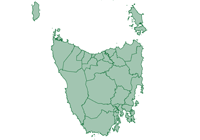This indicator shows the estimated number of employed residents of the local area, on an annual basis back to 2001. Employed residents may have a workplace anywhere, inside or outside the area. The dataset is derived from the National Economics microsimulation model, based on the ABS labour force survey.
A growing number of resident employed can indicate a growing economy, or a growing residential population, supplying labour to other areas. To build a more complete picture of the residential economy, this dataset should be viewed in conjunction with Local employment, Employment self-containment, Residents place of work by industry and Residents place of work by occupation datasets.
Current area:
Current benchmark:


| Employed residents | |||||||
|---|---|---|---|---|---|---|---|
| Tasmania | Greater Hobart | ||||||
| Year (ending June 30) | Number | % change | Number | % change | Tasmania as a % of Greater Hobart | ||
| 2023 | 286,693 | +2.39 | 132,340 | +1.81 | 216.63 | ||
| 2022 | 280,014 | +3.72 | 129,985 | +3.66 | 215.42 | ||
| 2021 | 269,979 | +3.07 | 125,400 | +2.95 | 215.29 | ||
| 2020 | 261,947 | +2.30 | 121,804 | +2.69 | 215.06 | ||
| 2019 | 256,066 | +1.32 | 118,619 | +2.08 | 215.87 | ||
| 2018 | 252,739 | +4.24 | 116,198 | +5.27 | 217.51 | ||
| 2017 | 242,465 | +1.54 | 110,379 | +2.04 | 219.66 | ||
| 2016 | 238,798 | -0.38 | 108,173 | +0.43 | 220.75 | ||
| 2015 | 239,718 | +2.92 | 107,711 | +3.57 | 222.56 | ||
| 2014 | 232,908 | -0.36 | 103,999 | +0.00 | 223.95 | ||
| 2013 | 233,752 | -1.01 | 104,004 | -0.36 | 224.75 | ||
| 2012 | 236,129 | -1.26 | 104,381 | -0.57 | 226.22 | ||
| 2011 | 239,138 | +1.29 | 104,977 | +1.23 | 227.80 | ||
| 2010 | 236,098 | -1.39 | 103,704 | -1.21 | 227.67 | ||
| 2009 | 239,427 | +3.19 | 104,979 | +3.01 | 228.07 | ||
| 2008 | 232,016 | +3.00 | 101,908 | +3.52 | 227.67 | ||
| 2007 | 225,253 | +0.94 | 98,440 | +1.49 | 228.82 | ||
| 2006 | 223,158 | +3.17 | 96,996 | +3.28 | 230.07 | ||
| 2005 | 216,300 | +2.49 | 93,912 | +2.60 | 230.32 | ||
| 2004 | 211,038 | +4.62 | 91,533 | +4.74 | 230.56 | ||
| 2003 | 201,719 | +1.53 | 87,394 | +1.28 | 230.81 | ||
| 2002 | 198,682 | -0.95 | 86,294 | -0.92 | 230.24 | ||
| 2001 | 200,582 | -- | 87,095 | -- | 230.30 | ||
Source: National Institute of Economic and Industry Research (NIEIR) ©2023. Compiled and presented in economy.id by .id (informed decisions). NIEIR-ID data are adjusted each year, using updated employment estimates. Each release may change previous years’ figures. Learn more Please refer to specific data notes for more information | |||||||
